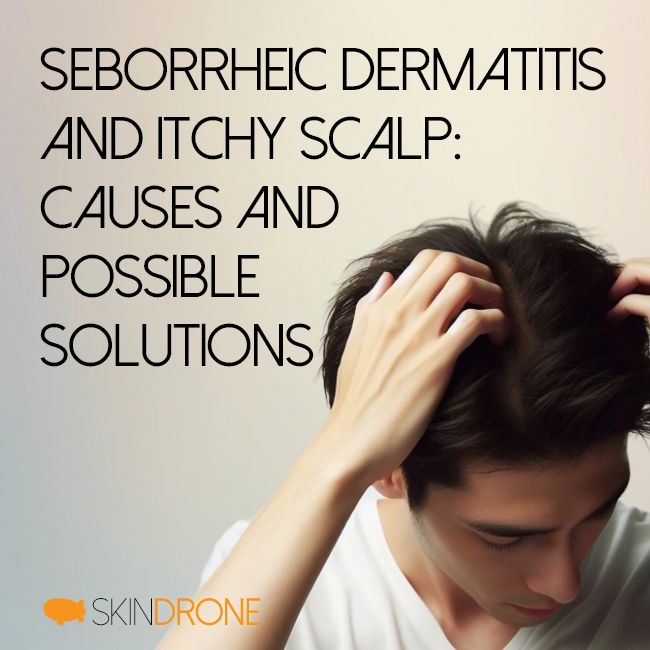- Seborrheic dermatitis causes flaky scales and intense itching, often on the scalp, face, and ears.
- Microbial imbalances, especially yeast overgrowth and bacterial shifts, are key itch triggers.
- Immune system dysfunction and a weakened skin barrier worsen the condition.
- Gentle skincare, medicated treatments, and identifying triggers are crucial for relief.
- Emerging biologic therapies offer hope for severe cases.
Seborrheic dermatitis is a widespread skin issue leading to flaky, white or yellowish scales on oily areas like the scalp, face, and ears. It can range from mild dandruff to thick, crusty scalp plaques [1]. For many, the relentless itch is the most frustrating symptom. Let’s explore what causes this itch and how to find effective relief.

Unpacking the Itch: Causes of Scalp Itch in Seborrheic Dermatitis
The exact reasons behind the bothersome itch in seborrheic dermatitis aren’t fully understood, but research points to several interacting factors:
Microbial Imbalance: The Skin’s Tiny Ecosystem
Compelling evidence highlights that changes in the skin microbiome are central to the inflammation and itch of seborrheic dermatitis [2]. Two key microbial shifts are identified:
- Yeast Overgrowth: An increased ratio of Malassezia restricta to Malassezia globosa yeasts.
- Bacterial Shift: A decreased ratio of Cutibacterium to Staphylococcus bacteria.
Malassezia yeast is a normal skin resident, but in seborrheic dermatitis, it can multiply excessively. Its byproducts penetrate the skin, triggering inflammatory substances (cytokines) and pruritogens – the culprits behind the itch. Higher levels of M. restricta compared to M. globosa are linked to more severe itching and inflammation [1].
Simultaneously, beneficial bacteria like Cutibacterium decrease, allowing harmful Staphylococcus bacteria to thrive. Staphylococcus virulence factors further compromise the skin’s protective barrier [4]. This combination results in the hallmark red, flaky, and intensely itchy skin.
Immune System Irregularities
Beyond microbial factors, immune system abnormalities likely contribute to the persistent itch. While earlier theories focused on an overactive immune response, newer research suggests immune dysfunction may lead to weakened defenses against microbes like Malassezia [5].
Genetic studies also suggest that inborn immune system variations might predispose individuals to seborrheic dermatitis flares [2]. The precise mechanisms of how immune disturbances cause itch are still being investigated. It’s thought that inflammatory mediators released by immune cells may activate the nerve fibers that sense itch.
Skin Barrier Breakdown
A compromised skin barrier is another significant piece of the itch puzzle in seborrheic dermatitis. Individuals with this condition often have an inherently weaker skin barrier. Additional factors like inflammation, scratching, harsh cleansers, or environmental stressors can further damage this barrier [6]. This creates a vicious cycle: a damaged barrier allows irritants, microbes, and allergens to penetrate deeper, fueling more inflammation and itch.
In essence, itch and inflammation in seborrheic dermatitis appear to be driven by the interplay of microbial imbalances, immune dysfunction, and skin barrier disruption. Further research is ongoing to fully clarify these complex mechanisms, paving the way for more targeted treatments.

Soothing the Itch: Effective Solutions for Seborrheic Dermatitis
Given the bothersome nature of itch in seborrheic dermatitis, what strategies can help manage and relieve it?
Identify and Minimize Triggers
Start by pinpointing potential triggers that might worsen your seborrheic dermatitis flares and itching. Common culprits include:
- Stress: Emotional stress and anxiety
- Environmental Changes: Weather shifts or humidity fluctuations
- Harsh Products: Skincare products that irritate the skin barrier
- Hormonal Fluctuations: Hormonal changes, especially in women
Managing or avoiding these triggers can help reduce the frequency and severity of itchy episodes.
Gentle & Consistent Skin Care
Treat your seborrheic dermatitis-prone skin with utmost gentleness. Focus on nurturing the stratum corneum – the outermost skin layer – through hydration and nourishment:
- Lukewarm Showers: Opt for lukewarm water instead of hot showers, which can strip the skin of moisture.
- Fragrance-Free Cleansers: Choose gentle, fragrance-free, non-foaming cleansers to minimize irritation.
- Rich Moisturizers: Apply soothing, lipid-rich moisturizers frequently to keep skin hydrated.
- Pat Dry: Gently pat your skin dry after washing, avoiding harsh rubbing.
This gentle approach strengthens the skin barrier and prevents dryness, which can exacerbate itching.
Topical Medications: Targeted Relief
For persistent seborrheic dermatitis, topical prescription medications can effectively reduce scaling, inflammation, and itching:
- Antifungal Shampoos: Ketoconazole shampoo and similar antifungals help control Malassezia yeast overgrowth.
- Corticosteroid Creams: Clobetasol propionate and other corticosteroids reduce inflammation and calm the itch.
- Calcineurin Inhibitors: Tacrolimus ointment and similar medications modulate immune reactions and reduce inflammation.
Combination therapy, using multiple topical agents, can enhance treatment effectiveness. Always adhere to your doctor’s instructions for application to minimize potential side effects.
Oral Supplements: Supporting from Within
Some research suggests that oral supplements may offer additional support for seborrheic dermatitis when used alongside conventional treatments:
- Probiotics: Beneficial bacteria that may help restore a healthier skin microbiome balance.
- Omega-3 Fatty Acids: Essential fatty acids that can support skin barrier function.
However, more research is needed to confirm the benefits and determine optimal dosages. Always consult with a dermatologist before starting any new supplements.

The Horizon of Treatment: Biologic Therapies
Exciting advancements are emerging in the treatment of severe, resistant seborrheic dermatitis with novel injectable biologic medications:
- Dupilumab: A biologic that targets specific inflammatory pathways involved in itch and inflammation.
- Ustekinumab: A biologic that blocks inflammatory signaling molecules.
These biologics offer precise modulation of the dysfunctional immune response at the root of seborrheic dermatitis. While not yet FDA-approved specifically for seborrheic dermatitis, early trials show significant improvements in scaling and itch severity. Biologics represent a promising future direction for managing problematic itch that doesn’t respond to standard treatments.

Holistic Itch Management: A Multi-pronged Approach
Because itch in seborrheic dermatitis is complex and multi-faceted, the most effective approach often involves combining several strategies:
- Restoring Microbial Balance: Targeting yeast overgrowth and promoting beneficial bacteria.
- Supporting Immune Regulation: Calming overactive or dysfunctional immune responses.
- Strengthening Skin Barrier Function: Repairing and maintaining the skin’s protective barrier.
- Breaking the Itch-Scratch Cycle: Reducing scratching to prevent further damage and irritation.
- Addressing Psychological Factors: Managing stress and emotional well-being, which can influence flares.
While a single, definitive cure for itchy seborrheic dermatitis isn’t yet available, ongoing research into the underlying causes of inflammation and itch offers hope for the development of new, targeted therapies in the future.
Key Takeaways for Itch Relief
While the precise reasons behind the itch in seborrheic dermatitis are still being unraveled, we have a strong understanding of how to manage it effectively. Think of it as addressing a three-pronged problem: the balance of skin microbes, your immune system’s response, and the integrity of your skin’s protective barrier.
Here’s a recap of the strategy:
- Gentle Skin Care: Treat your skin gently with mild cleansers, lukewarm water, and patting dry.
- Antifungal Treatments: Target yeast overgrowth with medicated shampoos and creams.
- Anti-inflammatory Approaches: Calm inflammation with topical corticosteroids or calcineurin inhibitors.
- Barrier Repair: Reinforce your skin’s barrier with moisturizers and by avoiding harsh products.
Managing seborrheic dermatitis is an ongoing process, not a quick fix. Expecting occasional flares is realistic, but long-term management is key.
Exciting research is underway, exploring approaches like microbiome-balancing therapies, advanced biologic medications, and innovative technologies.
For now, a personalized plan focusing on:
- Gentle Skin Care Practices
- Anti-inflammatory Medications
- Trigger Avoidance
can provide significant relief from the frustrating itch of seborrheic dermatitis. The future holds even more promising and convenient solutions for keeping your skin healthy and comfortable.

No Comments
Be the first to start a conversation